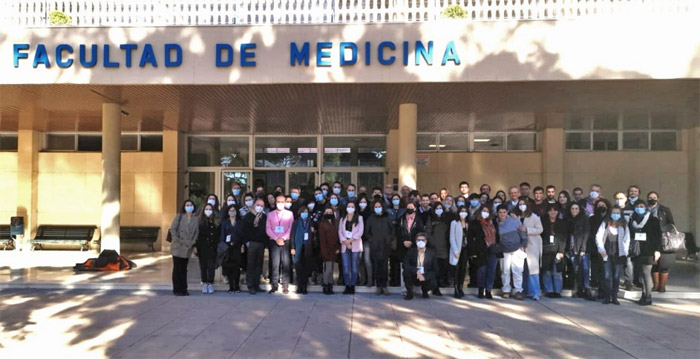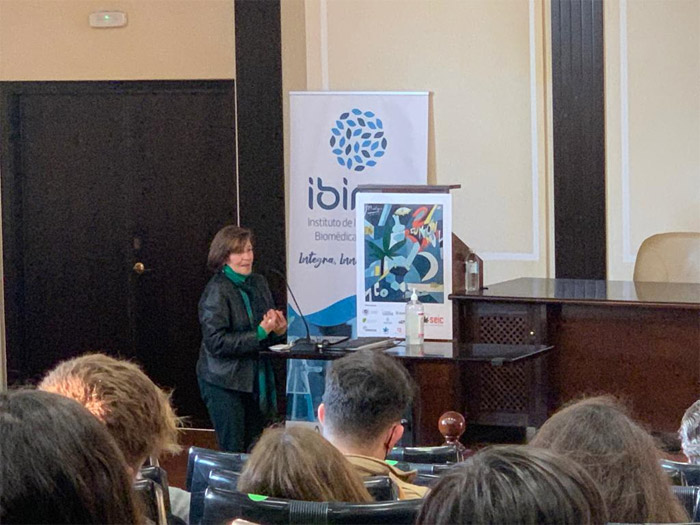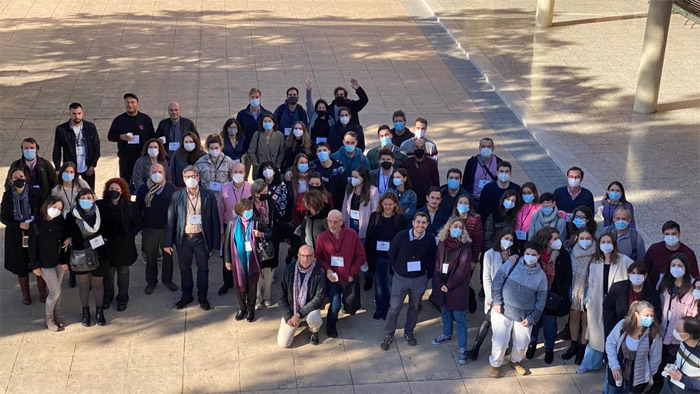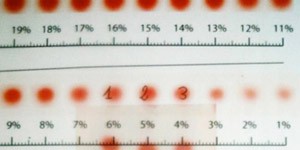By the SEIC Annual Meeting Organizing Committee
During the third week of November, the XXI Annual Meeting of the Spanish Society for Research on Cannabinoids (SEIC) was held in Malaga, after the break due to the coronavirus pandemic. The venue chosen for the occasion was the Aula Magna of the Faculty of Medicine of the University of Malaga. As in previous years, most of the participants were young researchers who, throughout the conference, presented the latest results of the studies in which they are involved, demonstrating once again the high scientific quality of Spanish research groups and, in particular, of those working on the study of cannabinoids.

The meeting opened with a few words from SEIC President Pedro Grandes, Deputy Vice-Rector for Research at the University of Malaga, Zaida Díaz, the Dean of the Faculty of Medicine José Pablo Lara, and the head of the SEIC Organising Committee, Juan Suárez, who welcomed all the attendees and highlighted the importance of holding this national conference in Malaga, as it is an appropriate moment to scientifically assess the therapeutic application of cannabinoid compounds in medicine. As in previous meetings, the inaugural talk was given by an internationally renowned researcher in the field of cannabinoids. On this occasion, the plenary talk was given by Silvana Gaetani, Professor of Pharmacology at the Sapienza University of Rome (Italy). Professor Gaetani highlighted Oleoylethanolamide (OEA), the natural compound derived from oleic acids and produced in the small intestine, also identified as an endocannabinoid, as a potential new pharmacological target for the treatment of binge eating disorder. Binge eating disorder is the most common eating disorder among the population, for which there are currently no effective and safe pharmacological treatments, which highlights the need for new treatment options. During her lecture, Prof. Gaetani explained how OAS, administered systemically in a dose-dependent manner, is able to prevent binge eating in a rat model. Prof. Gaetani explained that this behavioural effect was associated with a decrease in the activation of areas of the brain that respond to stress (such as the nucleus accumbens and the amygdala) and with a stimulation of areas involved in the control of food intake, such as the ventral tegmental area (VTA) and the paraventricular nucleus of the hypothalamus (PVN). These effects paralleled the modulation of monoamine transmission in key brain areas involved in the homeostatic and hedonic control of eating. In particular, a decreased dopaminergic response to stress was observed, albeit accompanied by an increased serotonergic and noradrenergic tone in the tissue of the selected brain areas. Prof. Gaetani then noted that OAS induced a decrease in corticotropin-releasing factor (CRF) mRNA levels in the central amygdala and an increase in oxytocin mRNA levels in the PVN. She further explained that the restoration of normal oxytocin receptor densities in the striatum paralleled the oxytocinergic stimulation produced by OAS.
Professor Gaetani concluded her talk by pointing to these studies as evidence suggesting that OAS could be used for the development of pharmacological therapies to treat compulsive eating disorders.
After the lunch break, the meeting resumed with the first of the scheduled sessions, which included 5 presentations on endocannabinoid signalling. During this session, studies were presented that showed the ability of astrocytes, the most abundant glial cells in the central nervous system (CNS), to release endocannabinoids, thus modulating the communication between astrocytes and neurons, and other works that studied the role of CB1 receptors in the modulation of oligodendrogenesis in vivo, thus helping to understand the complex network of signalling molecules that drive CNS myelination. This session also discussed tools to unravel cell type-specific CB1 receptor signalling, giving an updated view of the functional coupling of the CB1 receptor to Gi/o proteins in excitatory and inhibitory synaptic terminals. Studies are currently underway to understand the role of the CB1 receptor in the regulation of fear responses in POMC neurons, a small group of neurons in the hypothalamus, and its relevance in the control of food intake. It is also known that dysregulation of the hypocretin/orexin system, involved in the regulation of aversive memories, may contribute to the aetiology of fear and anxiety disorders. In this sense, the endocannabinoid 2-AG and CB2 receptor, probably located in the microglial cells of the amygdala, was connected in one of the talks to the altered disappearance of aversive memories caused by an overactivation of the orexin system.

This was followed by Hot Topic, an activity which has been in place for a few years and which has been very well-received by members and attendees. This consists of an expert in a field related to cannabinoid research presenting an updated review on a current topic. And the most topical issue was and continues to be, without a doubt, the SARS-Cov-2 pandemic. For this reason, on this occasion we were treated to an excellent lecture by Dr. Eduardo Muñoz (Professor and Lecturer of Immunology at the University of Cordoba), who spoke to us about the endocannabinoid system, cannabinoids, and COVID-19 infection. Dr. Muñoz mentioned the importance of the development of other therapeutic approaches to combat the SARS-Cov-2 virus, responsible for the current pandemic. The hot topic focused on the endocannabinoid system as a possible potential target to reduce lung inflammation, increase immunomodulatory effect, decrease human neutrophilic polymorphonuclear (PMN) infiltration, reduce fibrosis, and decrease viral replication, as well as to decrease the "cytokine storm". However, Dr. Muñoz concluded his talk by pointing out that, although the endocannabinoid system has many mechanisms that could provide certain benefits in the treatment of patients infected with SARS-CoV-2, more research is still needed to better understand the endocannabinoid system in COVID-19.
After the Hot Topic break, the day continued and the second session of oral communications was held: here the central theme was the endocannabinoid system in pathological states. Both CB1 and CB2 receptors and the enzyme FAAH are involved in the symptomatology and cellular mechanisms involved in neurodegenerative diseases. A cross-sectional study was explored, in which the association between plasma endocannabinoids and the cognitive status of a cohort of patients diagnosed with mild cognitive impairment (MCI) was evaluated, to discriminate between MCI with Alzheimer's disease (AD) and without AD. In this study, subsets of plasma endocannabinoids were identified as robust panels of biomarkers associated with MCI and AD in older patients. In addition, data confirming and extending the notion of a significant change in gene expression linked to genetic inactivation of the FAAH enzyme in the context of AD were also shown. Using the model of a mouse lacking the CB2 receptor on myeloid cells, such as microglia, this communication session also showed preliminary data indicating that CB2 cannabinoid receptors are involved in the regulation of activated microglial functions, which impact the dynamics of neuritic plaques, also called senile plaques or amyloid plaques, present in AD. On the other hand, since the chaperone protein BiP (also known as GRP78 or Hspa5) has recently been linked to the CB1 receptor function, a possible link between BiP and the neuroprotective effects of cannabinoids was discussed in the neuropathological context of the neurodegenerative diseases amyotrophic lateral sclerosis (ALS) and Parkinson's disease (PD). In addition, several papers on the role of the FAAH enzyme were mentioned: in particular, FAAH was mentioned as a prognostic marker and negative regulator of tumour progression and metastasis in breast cancer and, on the other hand, evidence of sexual dimorphism in the antinociceptive effects after FAAH inhibition was discussed.

The third session of communications took place on the second day of the congress and was divided into 3 blocks due to the large number of papers presented. The central theme of this third session was the characterisation of different cannabinoid compounds and their therapeutic effects. In the first block of this session, we talked about a compound, UVI-CB1-002, as an antagonist of CB1 and GPR55 receptors, which could be an interesting drug for the study of the endocannabinoid system, with a neuroprotective effect minimising toxic and/or psychotropic effects. Other works were also presented in which the affinity of the phytocannabinoids Δ9-THCA and Δ9-THCV, as precursor and homologue of Δ9-THC (THC), respectively, for cannabinoid receptors is being studied. On the other hand, the development of allosteric CB1 receptor modulators has become an area of immense importance within the field of cannabinoids for the treatment of different types of pain, inflammation, neurological disorders including neurodegenerative diseases, movement disorders (e.g. Huntington's disease), psychiatric disorders, glaucoma, addiction, and other pathological conditions where other pathways, such as agonists and inverse agonists, have not been successful or have produced certain side effects. In this regard, a compound, an extract of Juniper communis CO2 with potent and selective activity as a positive allosteric modulator for the CB1 receptor was discussed. Other works showed the effect of the combination of the natural cannabinoids THC and cannabidiol (CBD) on cognitive impairment in a mouse model of Alzheimer's disease. These authors found that this treatment improved cognitive impairment, and this improvement was related to a reduction in excitotoxicity, but not to a significant impact on the density and morphology of hippocampal dendrites in these mice. The session also discussed how Cereblon (CRBN), a protein mutated in humans with a mental retardation syndrome, interacts with the CB1 receptor, supporting a plausible molecular link between CRBN deficiency, memory malfunction, and CB1 receptor hyperactivation. Finally, the increase in the expression of the heteromer of the Cannabinoid receptor type 2 (CB2) and the n-methyl-d-aspartate (NMDA) receptor, CB2/NMDA, in both microglia and neurons of a mouse model of Alzheimer's disease was discussed in this session, thus becoming a potential therapeutic target for Alzheimer's disease.
After a short break, the second block of the third session of communications was opened. During this session, papers on the beneficial effect of a combined therapy with Cannabidiol and β-Caryophyllene for Dravet Syndrome were presented. This was followed by a series of communications on neonatal pathologies. In the next two talks, the protective potential of cannabidiol (CBD) on mood alterations was demonstrated, as well as its potential protection from brain damage due to neuroinflammation after perinatal arterial ischemic stroke in a new-born rat model. In particular, CBD was shown to be able to prevent the development of manic behaviour, as well as to modulate inflammation, by reducing microgliosis and increasing the polarization of activated microglia to an anti-inflammatory M2 phenotype. The effects of CBD on the inflammatory response after intraventricular haemorrhage (IVH), a common complication in new-borns with extremely low gestational age, which increases the risk of developing cerebral palsy, were also discussed. In this case, administration of CBD before and after aggression in a neonatal rat IVH model exerted an anti-inflammatory effect that prevented secondary brain damage and resulted in long-term structural and functional protective effects.
This session was followed by a round table discussion on the topic "From basic research on the endocannabinoid system to a business project", moderated by Dr. Juan Suárez (University of Málaga). Participants in this session were Dr. Fernando Rodríguez de Fonseca (SSPA Researcher Nicolás Monardes), Dr. Eduardo Muñoz (Professor of Immunology at the University of Cordoba), Dr. Nadine Jagerovic (Researcher at the Institute of Medicinal Chemistry, CSIC, Madrid) and Dr. Isabel Guerrero (Head of the Innovation and Technology Transfer Unit of the Public Health Service of Andalusia (SSPA) at IBIMA).
After the lunch break, the scientific meeting resumed with the last block of the third session of scheduled oral presentations, which included 4 talks, in which the studies being carried out on new-born rats were further discussed. First, the neuroprotective effect of a synthetic aminoquinone derivative of CBD, VCE-004.8, known to activate CB2 and the HIF (Hypoxia Inducible Factor) pathway in addition to PPARγ receptors after a stroke was discussed. These data showed robust neuroprotective effects, with a wider therapeutic window than reported for other neuroprotective strategies. Another paper mentioned how CBD prevented the deterioration of the blood-brain barrier by modulating the inflammatory response after infection by intraventricular haemorrhage in new-born rats. The relevance of the enantiomer form of specific cannabinoids in relation to their biological activity was subsequently discussed, a fact associated to a higher activity of the cannabinoid receptor, in particular of the CB2 receptor. Finally, the neuroprotective potential of VCE-006.1, a chromenopyrazole derivative with positive allosteric modulatory activity for GPR55, in mouse models of two neurodegenerative diseases, Parkinson's disease (PD) and amyotrophic lateral sclerosis (ALS), was discussed. These authors found that targeting GPR55 can provide neuroprotection in experimental PD, but not in experimental ALS, emphasizing the need for the development of cannabinoid-based therapies specific to each type of neurodegenerative disorder.

In addition to the communications presented, both as lectures and in panel format, this meeting was marked on this occasion by a particularly important and, above all, emotional event for the SEIC: the tribute paid to research professor and Head of the Neuroimmunology Group Carmen Guaza, on the occasion of her retirement. Different research colleagues were involved in honouring Carmen, expressing SEIC's public recognition, both scientifically and personally.
The third and last day of the meeting started with the fourth session of oral presentations where the most recent advances in research on the psychiatric effects of cannabinoids and other drugs of abuse, as well as signalling mechanisms, were presented. It was mentioned that regular consumption of a combination of THC and CBD in elderly people, previously shown to reduce cognitive decline in Alzheimer's disease, did not alleviate other neuropsychiatric symptoms in an aged Alzheimer's mouse model and that, more importantly, these natural cannabinoids could induce some psychotic-like effects in healthy elderly mice, in which the purinergic system seems to play a relevant role. On the other hand, results were presented on the effect of consumption of herbal mixtures Spice / K2, containing synthetic cannabinoids such as JWH-018 during adolescence. In this sense, it seems that exposure to JWH-018 during adolescence leads to the appearance of different behavioural alterations, such as anxiety and fear, which could depend on gender. On the other hand, in recent years, intensive work is being done on neurodevelopmental disorders such as schizophrenia, and the possible triggers of the disease, since it is believed that a maternal immune activation could initially induce a general susceptibility to the disease, and a second trigger could be exposure to cannabinoids during adolescence. Here, research was presented that used these rat models in both sexes, in which memory, social interaction, sensorimotor activation, and possible lasting changes in brain function were evaluated. The results presented indicated that unexpected interactions between two known vulnerability factors for schizophrenia should be further explored to determine their relevance to the clinical situation. In addition, stressful episodes, together with high alcohol consumption during adolescence, are also considered important risk factors for the development of psychiatric disorders in adulthood. However, based on the results obtained, the authors suggested the existence of partially different mechanisms for stress and alcohol exposure.
Once again, the annual meeting of the SEIC ended with the awards ceremony for the best annual publications by SEIC members; this year the number of awards was doubled, as it included publications for the year 2021 as well as those for 2020, which could not be awarded because of the pandemic. Finally, prizes for the best lectures and posters of the present meeting were awarded, and the event was closed after the farewell and closing words of the President of the SEIC, Dr. Pedro Grandes.


